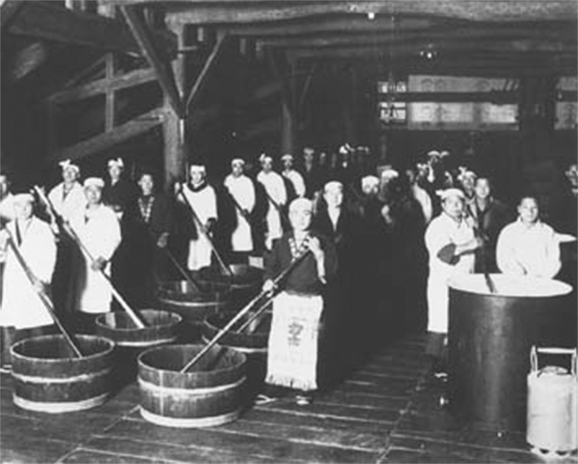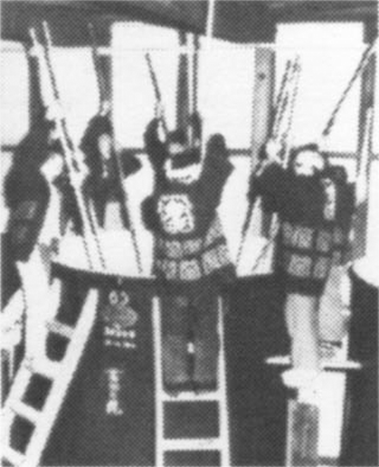Kamaya’s History

-
- 1748
-
Established Kamaya
Omi merchant, Shinpachi Kamaya, starts his sake brewing business at its current location which used to be a post town on the Nakayama Road. Shinpachi wrote in his family code of business, “Do not be careless in stocking up on your inventory, sell high-quality products for small profit, and win the trust of your customers. Those are the grounds for making your business last for a long time.”
- 1785
-
Naming of the “Rikishi” label
Kyuzaemon Komori, the older brother of the first Kayama owner, Shinpachi, named the sake as “Rikishi.” “Rikishi” comes from a passage from “Xiang Yang Ge” by a Chinese poet Li Bai. 舒州杓 力士鐺 (The ladle of Shuzhou, the small iron pot (for warming sake) of Lishi) 李白與爾同死生 (Li Bai shall share his fate with you). The ladle of Shuzhou was made in Shuzhou, which was a popular producer of drinking vessels during the Tang Dynasty. “The small iron pot (for warming sake) of Lishi” refers to an iron pot that was made by “Lishi (read as Rikishi in Japanese)” who was a great porcelain craftsman. It is said that they were Li Bai’s favorite drinking vessels.
- 1834
-
A disaster where the entire store burned down
On February 19, 1834, a large fire burned down most of the town. Kamaya lost its store, house, and warehouse where it kept its securities, assets, and rice. The company was left with nothing but a sake brewing building. However, the fourth owner, Kyuzaemon, was unfazed and made steady progress in planning the recovery of his family business into which he put all his efforts. Thanks to his efforts, he received 300 ryo from the magistrate’s office as a recovery fund and used that money to build the business back up.
-
- 1886
-
Sake storage construction (helping refugees who fled famine)
A famine that hit the Kanto region in 1886 resulted in many people seeking refuge. When that happened, Kamaya decided to construct a sake storage warehouse to help the refugees. This sake warehouse, which is still being used today, is mostly made out of Zelkova wood and has two stories with a gross floor area of about 661 m2. Because the purpose was to help refugees, the people back then called it the “Kamaya’s Relief Construction” to show their thanks to Kamaya.
- 1917
Established an unlimited partnership, Komori Shoten, which later became Kamaya.
- 1925
-
Selected by the Imperial Household Agency and won Japan Sake Awards
Kamaya also suffered large losses from the Great Kanto Earthquake in 1923 to a point where they were unable to keep their doors open for business. The earthquake caused a recession, and the sake brewing industry also suffered a big slump. Kamaya was also put in a difficult position, but in 1925, their Seishu Rikishi, received the honor of being chosen by the Imperial Household Agency, and in 1927, it won first place at the Japan Sake Awards. The recognition they received on the quality of their sake produced excitement among the employees, which increased sales and helped them overcome the recession.
-
-
- 1949
- Established Kamaya Corporation
- 1957
- Completed Fukuju Shrine
- 1978
- Completed Showa Shinzo (preparation warehouse)
- 1994
- Completed the Ginjo Warehouse
-
-
1748
Established Kamaya -
Omi merchant, Shinpachi Kamaya, starts his sake brewing business at its current location which used to be a post town on the Nakayama Road. Shinpachi wrote in his family code of business, “Do not be careless in stocking up on your inventory, sell high-quality products for small profit, and win the trust of your customers. Those are the grounds for making your business last for a long time.”
-
1785
Naming of the “Rikishi” label -
Kyuzaemon Komori, the older brother of the first Kayama owner, Shinpachi, named the sake as “Rikishi.” “Rikishi” comes from a passage from “Xiang Yang Ge” by a Chinese poet Li Bai. 舒州杓 力士鐺 (The ladle of Shuzhou, the small iron pot (for warming sake) of Lishi) 李白與爾同死生 (Li Bai shall share his fate with you). The ladle of Shuzhou was made in Shuzhou, which was a popular producer of drinking vessels during the Tang Dynasty. “The small iron pot (for warming sake) of Lishi” refers to an iron pot that was made by “Lishi (read as Rikishi in Japanese)” who was a great porcelain craftsman. It is said that they were Li Bai’s favorite drinking vessels.
-
1834
A disaster where the entire store burned down -
On February 19, 1834, a large fire burned down most of the town. Kamaya lost its store, house, and warehouse where it kept its securities, assets, and rice. The company was left with nothing but a sake brewing building. However, the fourth owner, Kyuzaemon, was unfazed and made steady progress in planning the recovery of his family business into which he put all his efforts. Thanks to his efforts, he received 300 ryo from the magistrate’s office as a recovery fund and used that money to build the business back up.
-
-
-
1886
Sake storage construction (helping refugees who fled famine) -
A famine that hit the Kanto region in 1886 resulted in many people seeking refuge. When that happened, Kamaya decided to construct a sake storage warehouse to help the refugees. This sake warehouse, which is still being used today, is mostly made out of Zelkova wood and has two stories with a gross floor area of about 661 m2. Because the purpose was to help refugees, the people back then called it the “Kamaya’s Relief Construction” to show their thanks to Kamaya.
-
1917年
Established an unlimited partnership, Komori Shoten, which later became Kamaya.
-
1925
Selected by the Imperial Household Agency and won Japan Sake Awards -
Kamaya also suffered large losses from the Great Kanto Earthquake in 1923 to a point where they were unable to keep their doors open for business. The earthquake caused a recession, and the sake brewing industry also suffered a big slump. Kamaya was also put in a difficult position, but in 1925, their Seishu Rikishi, received the honor of being chosen by the Imperial Household Agency, and in 1927, it won first place at the Japan Sake Awards. The recognition they received on the quality of their sake produced excitement among the employees, which increased sales and helped them overcome the recession.
-
-
-
-
1949
Established Kamaya Corporation1957
Completed Fukuju Shrine1978
Completed Showa Shinzo (preparation warehouse)1994
Completed the Ginjo Warehouse
-
-
- Philosophy
Kamaya’s Philosophy
-
- History
- Kamaya’s History
-
- coming soon
- Kamaya sake
-
- People
- Chief Brewer and Brewers


